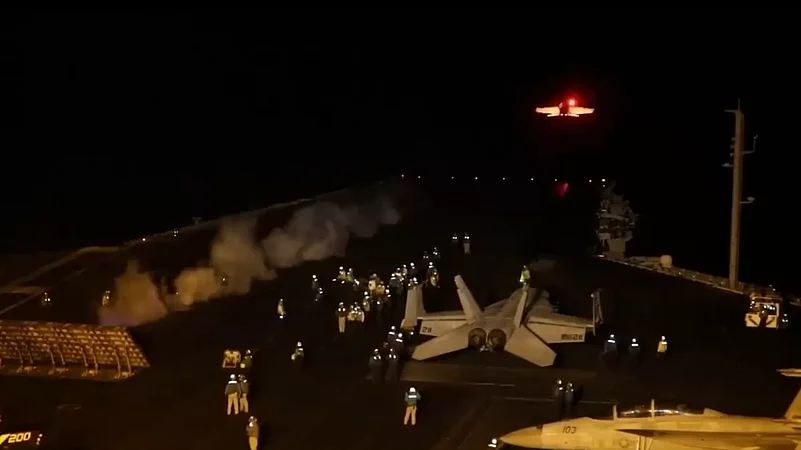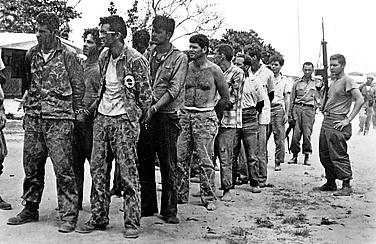After months-long rampage of the Yemen-based and Iran-backed Houthi militants in the Red Sea, the US and UK militaries on Thursday struck dozens of Houthi targets in a joint operation. A total of 60 targets at 16 Houthi sites across the length and breadth of Houthi-controlled Yemen were struck.
The strikes came after the Houthis mounted 27 attacks on commercial and military vessels in the Red Sea, which disrupted the global trade, led to surge in crude oil price, and pushed the Middle East to the brink of a wider conflict.
Following the US-UK strikes, US President Joe Biden said in a statement that "the United States and our partners will not tolerate attacks on our personnel or allow hostile actors to imperil freedom of navigation in one of the world's most critical commercial routes". He further said he would not hesitate to direct further operations if required to curtail the Houthi aggression.
Shortly after Hamas —also backed by Iran— mounted the worst-ever attack on Israel on October 7, the regional Iran-backed groups like Hezbollah in Lebanon and militias in Iraq and Syria opened hostilities against Israel and its principal ally United States in the region. The Houthis soon joined them and declared war on Israel. Houthis, who function under the banner of 'Ansar Allah (Partisans of God)', initially launched missiles at Israel, but then switched to attacking cargo and navy ships in the Red Sea, which connects Asia and Europe.
The US-UK strikes on Houthis come after the countries along with partners drew a 'red line' for the Houthis on January 3. For the past several weeks, the US and UK Navies in the region had been thwarting Houthi drones, missiles, and boat attacks. Then, on Tuesday, the Houthis launched the largest-ever barrage of missiles so far in the Red Sea, and a US-UK response was since then believed to be imminent. While the joint strikes are a punitive measure to curtail the Houthi belligerence and disruption, it is yet to be seen if this would curtail the militant group or push the region into an escalatory spiral.
Here we explain what we know about the US-UK military action, how Houthis destabilised the Red Sea, and why the stakes are so high at the moment.
60 Targets, 16 Sites, Air And Naval Strikes: How US, UK Hit Houthis
The US and UK fighter planes, comprising F-18s and Typhoons, struck over 60 targets at 16 sites in Houthi-controlled Yemeni territories. While the fighters hit the Houthi sites with the precision-guided missiles, US warships and submarines in the region also hit the targets with Tomahawk missiles.
While the US and UK militaries carried out the operation, it was supported by Australia, Bahrain, Canada, and the Netherlands, according to Biden.
While the US and UK militaries did not give the specifics about their targets, The New York Times reported that targets in seven cities were struck. The military bases in Sadeh, Sana, and Taiz; drone launch sites in Bani; the airport in coastal Abs; and targets near the airport in Hudaydah; and several targets in Zubaydah were struck, according to The Times.
The Houthi targets struck by the US-UK mission included command and control nodes, munitions depots, launching systems and sites, production facilities, missile and weapon storage sites, and air defence radar systems, according to the US military.
The US-Uk strikes were intended to "degrade" the capability of the Houthis "to continue their illegal and reckless attacks on US and international vessels and commercial shipping in the Red Sea", said US Central Command in a statement.
Following the strikes, a joint statement by US and partners said that while the aim is to de-escalate the situation in the region, there would be no hesitation in taking further action to address further belligerence of the Houthis.
"Today’s action demonstrated a shared commitment to freedom of navigation, international commerce, and defending the lives of mariners from illegal and unjustifiable attacks. Our aim remains to de-escalate tensions and restore stability in the Red Sea, but let our message be clear: we will not hesitate to defend lives and protect the free flow of commerce in one of the world’s most critical waterways in the face of continued threats," said a joint statement from the United States, the United Kingdom, Australia, Bahrain, Canada, Denmark, Germany, Netherlands, New Zealand, and South Korea.
How Houthis Disrupted Global Trade, Triggered Regional Crisis
With their first attacks, Houthis said they were attacking 'Israel-linked' ships, but that has not been the case. They have attacked ships owned and operated by other countries as well. The Houthis are carrying out their attacks out of their opposition to Israel. Much like Hamas, Hezbollah, and other Iran-backed groups, the Houthis also consider Israel and Jews as enemies and are opposed to the State of Israel. The slogan of Houthis sums up their position: "God is great, death to the US, death to Israel, curse the Jews, and victory for Islam."
Since the Houthi belligerence in the Red Sea began, the US and other European navies, mainly the UK and French, stepped up and began thwarting drones and missile attacks. Lately, in the first such face-off, US helicopters also sunk three Houthi boats involved in an attack. In response to the continuing Houthi belligerence, the United States announced a 10-nation naval force under the mission 'Operation Prosperity Guardian' to protect shipping in the region. While India is not part of the mission, it has deployed up to 10 warships to the region as stakes are high for India as well. The Thursday's US-UK strikes were, however, outside of the framework of the 'Operation Prosperity Guardian'.
The Red Sea is one of the most crucial waterways in the world. The Suez Canal, which is the egress point in the sea's west, connects Europe and Asia. The Bab el-Mandeb Strait is the eastern point of entry into the sea and separates Africa and Asia. The Red Sea accounts for 30 per cent of the world's ship container traffic, 12 per cent of all trade, and 10 per cent of total oil trade, according to expert estimates. The stakes are thus high.
Following the Houthi belligerence, global energy major BP and top shipping companies MSC, Maersk, Hapag-Lloyd, and Cosco suspended operations in Red Sea. These companies are taking the much longer route by going around the entire Africa to connect the East and the West. This would add millions in costs and add several days in deliveries, thus disrupting the world's supply chains. Moreover, the increased costs would be passed on to customers in the end, which would mean the commodities being shipped would come at a higher price. The New York Times reports that over 2,000 ships have to had to make such longer journeys so far.
Oil prices, which have a multiplier effect on inflationary cycles, have already been rising for weeks now since the disruptions in the Red Sea began.
Concerns Over Escalation In Middle East
The Houthi aggression and the retaliatory US-UK strikes have raised concerns that the region could slip into an escalatory spiral. But the cost of not doing anything and let the Houthis and Iranians carry out the rampage in the Red Sea would have been much higher, so the United States and partners had to act.
The tensions in the Middle East are high as Iran-backed groups are not going quiet. So far, even though the fighting between Israel and Hamas has not spilt over into the broader region, Iran-aligned groups have done everything short of an overt ground assault that has led to fears that such a spillover may happen at some point.
At the onset, Hezbollah in Lebanon opened a second front against Israel that led to the evacuation of dozens of towns and over 100,000 in Israel. The exchange of fire has continued almost non-stop between Hezbollah and Israel. Similarly, the aggression of Houthis has also raised fears of a broader regional conflict. The assassinations of top Hamas and Hezbollah leaders in Lebanon have also raised the stakes. Moreover, Iran-backed groups have also been attacking US forces in Iraq and Syria and have incurred several US strikes in response.
Following the strikes, Sky News Defence and Security Editor Deborah Haynes noted that while the US-UK strikes in Yemen are a calculated escalation to deter threats, there is still a potential of a regional war. The key to how this plays out will be Iran's response, noted Haynes.
Even though there is a risk of an escalation, doing nothing was clearly not an option, says Haynes. That would be tantamount to giving Iran and its proxies a free hand.
"With Yemen, the decision to attack in a region already teetering on the brink of wider conflict amid Israel's war in Gaza is a high-risk balancing act. Hit the Houthis too hard and their supporters, most notably Iran, would have to strike back more significantly. Yet, if the intervention is not strong enough, it will fail sufficiently to degrade Houthi military capability and not deter further attacks against international shipping," noted Haynes in an article.


























